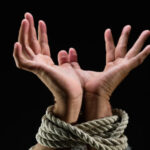Women and Children First
By Mary E. Hunt
Human trafficking is a mega-billion dollar global industry unregulated by any country or international body. It is a criminal activity ignored and/or tolerated with devastating consequences for the person involved, most of whom are women and children.
Trafficking ranks just behind drug and arms trading as the most lucrative forms of commerce. Religiously informed social justice groups need to add this unspeakable activity to our agendas and bring the resources of our religious traditions to the task of eradicating it. I only wonder why it has taken some of us this long to focus our attention on an all too common phenomenon.
It is no surprise that the vast majority of trafficked persons are women and children. Nor is it any shock that most of those who do the trafficking are men. That is simply the power configuration of patriarchy/kyriarchy with trafficking fitting the paradigm exactly, including racial/ethnic minorities being disproportionately represented. As such, trafficking is simply another way that women and children are pawns in an out-of- balance world. No wonder we do not even notice.
The United Nations estimates that between 700,000 to 4 million women (most between ages 18 and 24) and children are involved in trafficking. Their stories vary slightly but the outline is the same. They are moved around like chess pieces for prostitution, illegal labor, and drug-related activities. Most of them experience physical and/or sexual violence. Their vulnerability in the larger context of economic and sexual inequality leaves them ripe for this kind of exploitation.
Recruiters are usually strangers who make a persuasive case to women in need. But a large percentage of those who engage women in trafficking are actually relatives or friends of the family. One study of trafficking done in 2007 indicated that only one person was actually convicted for every 800 people who were trafficked. A logical conclusion is that trafficking is morally and legally trivial in an unjust world.
Trafficking works in such perfect synch with the larger system that most of us in the privileged West can ignore it without blinking because it never passes our screens. Yet it is a dimension of every war, flood, famine, hurricane, and earthquake when people are uprooted without regard for their safety or well-being. Unscrupulous agents take advantage of their situations, prey upon those who are young and vulnerable, and dupe those who seek to better their lots. The moral repugnance of trafficking is only outdone by its criminality.
A major reason why women are ‘willing’ to move from their country of origin to another country is the lure of a safer, more fruitful life for themselves and their children. Trafficking is a ‘natural’ part of the movement of peoples we call migration. In fact, many women respond to bogus offers of employment and help with immigration when in fact they are really assenting to their own servitude.
They find on the other end that they have been bound into prostitution, are raped and sometimes tortured by the same men they had trusted to help move their families to places where they were told there is work.
Rather than becoming legally employed as waitresses or domestic workers, these women end up in prostitution, where they face the added burdens of unwanted pregnancy, HIV/AIDS and other sexually transmitted diseases, and a negative social stigma.
Whether in Benin or Berlin, Minneapolis or Mumbai, the patterns are remarkably common.
Trafficked women are used to entice other women into the process. They are used as examples of people who have ‘made it’ in another country, can send money home, or seem to be living a more comfortable life. But the price they pay is higher than what their friends and family can see from afar. It is a debt their families will pay for generations to come.
Stories of trafficked women and children are hard to read, harder still to incorporate into an analysis of how to rid the world of this hideous dynamic.
Societies that dishonor women by keeping girls from education, by limiting reproductive choices (especially contraception and safe abortion), or by prohibiting women from certain jobs because of their gender should not be surprised when women are trafficked.
Poverty is a powerful motivator for parents who wish a better life for their children. When parents entrust their children to friends and relatives who claim they will enhance their children’s chances, parents unwillingly and unwittingly risk their children falling into the hands of traffickers.
The scope and ubiquity of the problem confound: from the smallest towns in Africa to the biggest cities of Europe, from the teeming streets of Asian capitals to the tranquil towns of the American Midwest.
Obviously trafficking has tacit support from some law enforcement officials, border patrols agents in many places, and perhaps even from corrupt governments. It is a product of organized crime and a by-product of gang activities. Yet the result is always the same —women and children harmed.
I stretch to find resources equal to the enormity of the problem. One promising font of insight and advocacy is a new anthology edited by MacArthur Award-winning historian Bernadette J. Brooten, “Beyond Slavery: Overcoming Its Religious and Sexual Legacies.”
In her anthology, Dr. Brooten and her collaborators trace the history of slavery in order to show the vestigial ways in which it is still very much a part of our world. They demonstrate that the sacred texts of major religious traditions like Judaism, Islam, and Christianity have not been unequivocal in their condemnation of slavery. For example, Jesus never outlawed it. The gestalt of this project is to lay bare the scaffolding of slavery and provide tools for eradicating it.
Human trafficking is a close cousin of slavery. Though Dr. Brooten and her marvelous array of scholars, activists, and artists do not take it on directly, there is much to learn from, and their approach can be useful in the struggles to outlaw trafficking.
First, they take a deep look at the history and contours of slavery. This needs to be done in order to draw an accurate map of where and how women and children are moved about, in what regions and countries people are most at risk.
Second, they bring a multi-disciplinary approach to the topic including everything from religion to hip-hop music, from law and anthology to autobiographical accounts of slavery. Finally, they extrapolated from the historical data on slavery to contemporary ways in which women are mistreated, ways in which sexual play can mimic slavery. The same method would be helpful on trafficking. First- person accounts provide reality to what can remain an abstraction. A good play, even a musical that would educate audiences, remains to be written on trafficking. Some artistic ways of elucidating the painful reality might invite more outrage a la “The Vagina Monologues.”
A long look at human trafficking will reveal the ways in which it has been considered normal, the extent to which many women have no say in their whereabouts, no choice in their work, no control over how their children will be used/abused. In addition, legal studies and a review of government policies can reveal the many loopholes that allow trafficking to continue unchecked.
Women and children used to come first in the social order because of their perceived vulnerability. Regrettably, women’s movements around the world in recent decades did not bring an end to that vulnerability. Indeed, with increased distance between the moneyed and the rest of us, I daresay women and children are at more of a risk than ever.
With trafficking of women and children now a big business, eradicating it has to become a priority agenda item for all who seek justice, lest trafficking be considered “too big to fail.”
This article can also be found in 8th Day Center for Justice’s publication “Centerings.”


